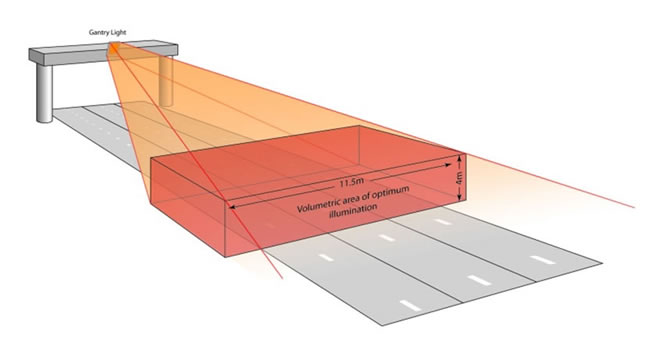Area of illumination for ANPR / LPR projects
This is the actual illumination area on-road in which adequate light intensity has to be provided for applications involving automatic number plate recognition. As shown in the figure below, it may not necessarily be a single point but can include several tens of metres of distance across several road lanes.

Confusion can arise because of the current absence of standards. Lighting efficiencies also need to be considered. LEDs' efficiency is much higher than that of older halogen lights, producing significantly more lumens per watt, and some manufacturers will state that a higher wattage denotes higher performance but this is not necessarily so,input power to a lighting product does not necessarily translate into output power at the LED. This can significantly reduce overall performance and the lighting intensity delivered at the point of need may be less for a 'high-power' product with greater wattage than for a well-designed alternative which, on paper at least, is 'less powerful'.
The unit of measurement for visible illumination, the lumen, takes account of the spectral response of the human eye and gives an idea of how bright the eye perceives a light to be. Although cameras tend to have a similar response, a lumen value does not necessarily indicate how bright a camera will perceive a light to be. The lumen should be considered a unit of measurement for the total amount of light output from a light emitter (otherwise known as 'luminous flux'). However, it is important to know how this light will be used, and this relates to the area that needs to be illuminated.
Light intensity in a target area is measured in lux – and one lux is equal to one lumen per square metre. The lux is therefore a good unit of measurement with which to determine and compare the brightness of a beam in the visible light spectrum. The beam is spread over a specific area and therefore we use lux to measure visible light intensity.
The amount of power consumed, measured in watts, can be used in conjunction with the lumen to provide a measure of the efficiency of a light emitter. For a visible light source, power (watts) should not be taken as a sole indication of light output or intensity because of potential differences in efficiency of chosen lighting technologies and performance of individual manufacturers' products.
The watt is used in conjunction with infra-red illumination, however, to provide a measure of radiant intensity, the unit used tends to be watts/steradian (the steradian being the SI unit for measurement of solid angle).
In many instances, the only way to guarantee all of the above is to test in typical situations. Gardasoft undertakes such testing on behalf of clients and is able to respond very quickly to test results with optimised solutions.
Lumens is a measure of the potential light output, Luminous intensity (Lux) measures visible light at the point of image capture. Watts/m2 is a measure of the radiance of non-visible light (IR) at the point of image capture.
Traffic technology White Paper
LED Traffic Strobe Lights - for high intensity ANPR and LPR applications

